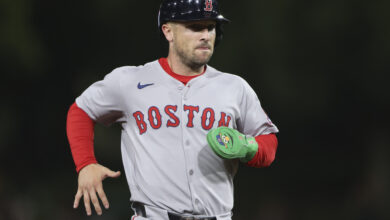
Cubs Once Again Linked to Corey Seager, Predictions Might Be More Than Idle Chatter
I don’t think anyone needs to be told at this point that free agency predictions can’t all be taken seriously, particularly when we’re still so early in an offseason that might stretch out much longer than usual. But even if you approach such pieces with more than a healthy degree of skepticism, you have to kind of cock your head to the side with interest when you keep seeing the same names tied to the same team(s).
That’s the case with the Cubs and Corey Seager, the (almost) consensus No. 2 overall free agent this winter who is projected to command something in the neighborhood of $300 million. A report from back in October said the Cubs had been “cultivating information” on the top free agent shortstops, then MLB.com’s Mark Feinsand listed them among the six most likely suitors for Seager.
Now comes a prediction from RJ Anderson of CBS Sports that Seager will sign with the Cubs. He’s also got Kris Bryant going to the Mets with both Javier Báez and Nick Castellanos going to the Phillies in the event that you care about such things.
Anyway, here’s the blurb on Seager:
The Cubs have been signaling, both publicly and privately, that they intend to spend money this winter. Seager would provide a face to their new-look roster while also giving their lineup a much-needed boost. That Seager may have to eventually slide off shortstop seems like less of a problem for a team in transition than it was for, say, the Dodgers.
What catches my attention right away, and not just because it’s only six words in, is the part about the Cubs signaling both publicly and privately. As someone who will get little tidbits from time to time that can’t be fully reported, this sounds like more than just inconsequential word choice. If that’s the case, it would mean this isn’t just a matter of agents trying to leverage another big-market team in order to stoke more competition for their clients.
It would also lend a little credence to what Jed Hoyer has been saying about the team’s ability to spend, though he’s also been careful to temper expectations about megadeals that run perhaps a decade into the future.
“As you layer on years, obviously, you’re layering on a lot of risk to any transaction,” Hoyer said last week. “By definition, projecting a player’s performance gets harder and harder as you get away from their last year and their last couple years. Any time you do that, you’re introducing risk.
“Listen, I’ve been a part of long deals that worked exceptionally well. And I’ve been a part of long deals that didn’t. You just accept that going into them, by definition, you’re introducing more risk into the transaction when you layer on years [emphasis mine].”
Where a lot of people took that as Hoyer more or less saying the Cubs would avoid massive deals, I simply see a statement about how such contracts must be evaluated. If you read that last sentence again separate from the prior comments, you could almost come away believing it’s an admission that the Cubs are indeed targeting a top free agent. Rather than saying they’re trying to avoid a big risk, it may simply be a matter of figuring out which player represents the least amount of risk relative to the investment.
Please understand that I’m not necessarily saying I believe that’s what Hoyer meant here. I can, however, find a pretty easy path to that being the case in spite of what we’ve seen from the Cubs when it comes to spending big on free agent position players. There comes a point when you have to stop being scared about repeating the Jason Heyward deal, though whether that’s this winter with Seager obviously remains to be seen.
Back to Anderson’s assessment, the other thing that really stood out to me was the part about how Seager eventually having to move from short would be less of a problem, or risk, for the Cubs. That’s something I brought up when writing about the Feinsand piece, noting that the Cubs have several young shortstops at the lower levels of the minors who could conceivably be ready for the role by the time Seager needs to shift.
There’s a more immediate need for both an everyday shortstop and left-handed power, so the Cubs could view Seager as the leader of a quick turnaround. All the current infielders are right-handed batters and the combination of Nico Hoerner and Nick Madrigal has combined for five homers in 702 total plate appearances. The Cubs have also fared poorly against high velocity and have produced too much swing-and-miss over the last few seasons, trends Seager could help reverse.
There’s value to having a new face-man as well, something ownership surely understands in the wake of decreasing season ticket renewals.
I still think it’s a longshot that the Cubs eventually get serious about Seager or Carlos Correa, who is expected to earn even more, but my clothes are starting to smell a little like smoke here. We may find out soon whether there’s anything to this talk because there’s an increasing belief around the league that Seager and Marcus Semien, both of whom are repped by Scott Boras, are willing to sign prior to the December 1 CBA expiration.
That’s barely over two weeks away, so you might not have to put up with these hypothetical think-pieces much longer.

